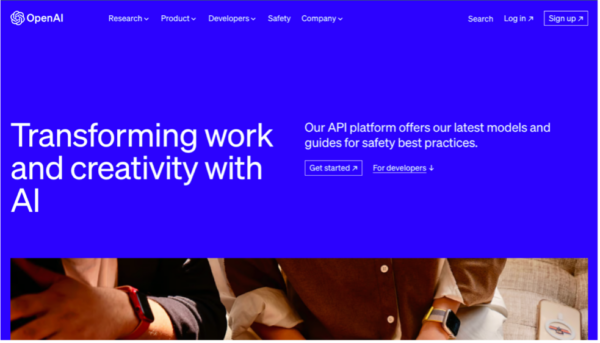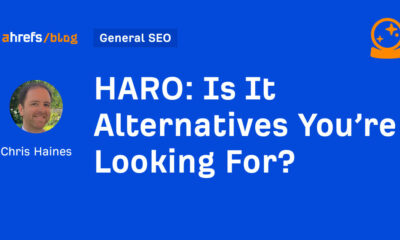MARKETING
Storytelling Helps in B2B Product Marketing, Too

Product differentiation theory goes back 90 years to economist Edward Hastings Chamberlin’s book Theory of Monopolistic Competition.
Let me save you the read and share his view on product or service differentiation, which is still in use today:
A general class of product is differentiated if any significant basis exists for distinguishing the goods (or services) of one seller from those of another. Such as basis may be real or fancied, so long as it is of any importance whatever to buyers and leads to a preference for one variety of the product over another.
He goes on to describe three differentiation categories that are very relevant to product marketing: vertical, horizontal, and mixed.
Many marketers, including me, say differentiation is one of the most difficult things to get right – and very few nail it. But here’s the good news: Storytelling (once again) comes to the rescue.
Before I explain how, let’s look at why marketers struggle so much with differentiation.
Many marketers say product differentiation is one of the most difficult things to get right – and few nail it, says @Robert_Rose via @CMIContent. #ProductMarketing Click To Tweet
Why product differentiation in marketing is so difficult
It’s easy to see the differentiation buckets (vertical, horizontal, and mixed) and say, “OK, great, I’ll focus on that one.” But picking one can be extraordinarily difficult.
Customers are irrational. Getting customers to identify how they make decisions is almost impossible, especially for complex purchases. Contextual conditions, emotions, and other factors, including memory, can inhibit marketers from choosing the correct horizontal or vertical differentiators.
Some competitors aren’t competitors. Your company’s top competitors are often not the best comparison. Nor can you differentiate your brand against perceived competitors. New and less-clear markets are particularly susceptible to this. I hear tech startups say, “We’re in a category all by ourselves.” My response is, “That’s not a good thing.” It’s hard to find differentiation if there’s nothing to differentiate against.
Things change quickly. Continually monitoring customers and going deeper into competitive, contextual, and other market differentiation is difficult. Today’s market moves quickly. It can often be faster to throw differentiators against the wall and see what sticks.
Then, the categories themselves involve challenges.
Vertical differentiation depends on the customer’s hierarchy. In this category, differences among products are objective. Customers identify discernable options and rank the products’ quality and prices. They choose based on their hierarchy of highest to lowest quality. For example, a customer picks an Apple computer because the brand is known for high-quality products. Or someone selects a frozen pizza because its calorie count is the lowest. Perhaps the buyer chooses a known brand over an unknown brand.
An old saying in the consulting industry, “Nobody got fired for hiring IBM,” is an example of vertical differentiation.
Horizontal differentiation depends on customer feelings. Horizontal product differences are subjective because no objective ranking can distinguish the “best.” Customers choose based on what they like best at that moment. Someone who prefers vanilla chooses a shake of that flavor rather than a chocolate one. An iPhone customer picks the purple model because that’s their favorite color. Or the company selects an enterprise software package because your CEO liked that salesperson the best.
Mixed differentiation comes into play on complex purchases. More considered or complex purchases usually fall into the mixed differentiation category. Customers use vertical and horizontal differentiation in varying combinations. For example, a couple planning to buy a new car considers many objective metrics (gas mileage and safety rankings) and subjective ones (friendliness of sales staff) when deciding among brands.
But defaulting to mixed messaging rarely works
Each differentiation approach has a different focus in product marketing. In vertical differentiation, marketers focus on the features customers rank as super important. That could be price, bells and whistles, or anything that distinguishes the product in the customer’s mind.
On the other hand, horizontal differentiation revolves around letting the buyer know that “people just like you” make this choice. It’s designed to help the customer make a decision.
For example, a restaurant packages several of its menu items into a combo and denotes, “People with a big appetite prefer this option.” The restaurant built in differentiation even though the food items also can be sold separately. An online store could help the buyer decide by showcasing variety: “Here’s a rainbow of colors for your selection.” Or it might suggest a product with “Buyers like you purchased this item.”
Mixed differentiation balances both horizontal and vertical considerations.
Marketers often default to mixed differentiation because they don’t understand how they should differentiate their product market. They either don’t understand the customer well enough to know the ranked preferences or think they must invent differences because they offer a commoditized product.
Remember the failed “phablet”? Devices sized between a phone and a tablet sprang up over a decade ago. While larger phones and smaller tablets ultimately succeeded in the marketplace, the phablet moniker didn’t.
Marketers sometimes use mixed differentiation to get the best of both worlds. You see it in phrasing such as:
- Efficiently unlock high performance
- Fully integrated and modular
- Transform your business while being able to focus on the basics
- Powerfully complex and intuitive to use
- Benefit from data-driven creativity (my new favorite).
This occasionally confusing differentiation shows up even in the most modern companies and marketing.
OpenAI’s product page, for example, features the headline “Transforming work and creativity with AI.” Adjacent to that header is the text, “Our API platform offers our latest models and guides for safety best practices.”

Source: OpenAI
I don’t want to pick on the copywriting team, but I wonder why they separate work and creativity. Are they different? Is it important to transform them separately? Do the writers believe their customers rank those elements as most important? Or are the writers taking a horizontal approach to showcase AI’s variety of benefits?
In the page copy, they focus more on vertical differentiation by highlighting the qualitative features of their API platform to differentiate it from other generative AI products. But do they succeed?
Therein lies an inherent challenge with mixed differentiation – intentional or otherwise. It often amounts to just clever ways not to say much at all.
Storytelling can help you differentiate
Storytelling often shows up in content and brand marketing, where it lets you tell customer experiences more effectively or relate your brand’s origin story.
But storytelling also works to position product marketing differentiation. When done well, a great story connects and aligns audiences to bigger themes or points of view. It aligns those views with the marketer’s desired differentiators. Stories can help people care about things they didn’t know they cared about.
Storytelling in #ProductMarketing can help people care about things they didn’t realize they cared about, says @Robert_Rose via @CMIContent. #Content Click To Tweet
Tech vendor SAP’s nine-part podcast series Searching for Salai is a great example. The content campaign supported the launch of a product and service solution called Leonardo, which combined AI technology, blockchain, and the Internet of Things.
The podcast told the story of a time-traveling art history buff’s investigation into (and an interview with) a mysterious person who may be the long-time apprentice of Leonardo DaVinci. The time traveler demonstrates how innovation arises from the combination of technology, data, and people.
Can you guess which solution differentiators SAP wanted to focus on in their marketing for Leonardo?
Storytelling gives you the best of both worlds (irony duly noted). It lets you choose how to differentiate while helping you convince your customer to care about your differentiators.
Classic product differentiation is about trying to meet customers’ prioritized preferences. Great storytelling helps you create preferences that customers will prioritize.
It’s your story. Tell it well.
Cover image by Joseph Kalinowski/Content Marketing Institute
MARKETING
How To Develop a Great Creative Brief and Get On-Target Content

Every editor knows what it feels like to sit exasperated in front of the computer, screaming internally, “It would have been easier if I’d done it myself.”
If your role involves commissioning and approving content, you know that sinking feeling: Ten seconds into reviewing a piece, it’s obvious the creator hasn’t understood (or never bothered to listen to) a damn thing you told them. As you go deeper, your fingertips switch gears from polite tapping to a digital Riverdance as your annoyance spews onto the keyboard. We’ve all been there. It’s why we drink. Or do yoga. Or practice voodoo.
In truth, even your best writer, designer, or audiovisual content creator can turn in a bad job. Maybe they had an off day. Perhaps they rushed to meet a deadline. Or maybe they just didn’t understand the brief.
The first two excuses go to the content creator’s professionalism. You’re allowed to get grumpy about that. But if your content creator didn’t understand the brief, then you, as the editor, are at least partly to blame.
Taking the time to create a thorough but concise brief is the single greatest investment you can make in your work efficiency and sanity. The contrast in emotions when a perfectly constructed piece of content lands in your inbox could not be starker. It’s like the sun has burst through the clouds, someone has released a dozen white doves, and that orchestra that follows you around has started playing the lovely bit from Madame Butterfly — all at once.
Here’s what a good brief does:
- It clearly and concisely sets out your expectations (so be specific).
- It focuses the content creator’s mind on the areas of most importance.
- It encourages the content creator to do a thorough job rather than an “it’ll-do” job.
- It results in more accurate and more effective content (content that hits the mark).
- It saves hours of unnecessary labor and stress in the editing process.
- It can make all the difference between profit and loss.
Arming content creators with a thorough brief gives them the best possible chance of at least creating something fit for purpose — even if it’s not quite how you would have done it. Give them too little information, and there’s almost no hope they’ll deliver what you need.
On the flip side, overloading your content creators with more information than they need can be counterproductive. I know a writer who was given a 65-page sales deck to read as background for a 500-word blog post. Do that, and you risk several things happening:
- It’s not worth the content creator’s time reading it, so they don’t.
- Even if they do read it, you risk them missing out on the key points.
- They’ll charge you a fortune because they’re losing money doing that amount of preparation.
- They’re never going to work with you again.
There’s a balance to strike.
There’s a balance to be struck.
Knowing how to give useful and concise briefs is something I’ve learned the hard way over 20 years as a journalist and editor. What follows is some of what I’ve found works well. Some of this might read like I’m teaching grandma to suck eggs, but I’m surprised how many of these points often get forgotten.
Who is the client?
Provide your content creator with a half- or one-page summary of the business:
- Who it is
- What it does
- Whom it services
- What its story is
- Details about any relevant products and services
Include the elevator pitch and other key messaging so your content creator understands how the company positions itself and what kind of language to weave into the piece.
Who is the audience?
Include a paragraph or two about the intended audience. If a company has more than one audience (for example, a recruitment company might have job candidates and recruiters), then be specific. Even a sentence will do, but don’t leave your content creator guessing. They need to know who the content is for.
What needs to be known?
This is the bit where you tell your content creator what you want them to create. Be sure to include three things:
- The purpose of the piece
- The angle to lead with
- The message the audience should leave with
I find it helps to provide links to relevant background information if you have it available, particularly if the information inspired or contributed to the content idea, rather than rely on content creators to find their own. It can be frustrating when their research doesn’t match or is inferior to your own.
How does the brand communicate?
Include any information the content creators need to ensure that they’re communicating in an authentic voice of the brand.
- Tone of voice: The easiest way to provide guidance on tone of voice is to provide one or two examples that demonstrate it well. It’s much easier for your content creators to mimic a specific example they’ve seen, read, or heard than it is to interpret vague terms like “formal,” “casual,” or “informative but friendly.”
- Style guide: Giving your content creator a style guide can save you a lot of tinkering. This is essential for visuals but also important for written content if you don’t want to spend a lot of time changing “%” to “percent” or uncapitalizing job titles. Summarize the key points or most common errors.
- Examples: Examples aren’t just good for tone of voice; they’re also handy for layout and design to demonstrate how you expect a piece of content to be submitted. This is especially handy if your template includes social media posts, meta descriptions, and so on.
All the elements in a documented brief
Here are nine basic things every single brief requires:
- Title: What are we calling this thing? (A working title is fine so that everyone knows how to refer to this project.)
- Client: Who is it for, and what do they do?
- Deadline: When is the final content due?
- The brief itself: What is the angle, the message, and the editorial purpose of the content? Include here who the audience is.
- Specifications: What is the word count, format, aspect ratio, or run time?
- Submission: How and where should the content be filed? To whom?
- Contact information: Who is the commissioning editor, the client (if appropriate), and the talent?
- Resources: What blogging template, style guide, key messaging, access to image libraries, and other elements are required to create and deliver the content?
- Fee: What is the agreed price/rate? Not everyone includes this in the brief, but it should be included if appropriate.
Depending on your business or the kind of content involved, you might have other important information to include here, too. Put it all in a template and make it the front page of your brief.
Prepare your briefs early
It’s entirely possible you’re reading this, screaming internally, “By the time I’ve done all that, I could have written the damn thing myself.”
But much of this information doesn’t change. Well in advance, you can document the background about a company, its audience, and how it speaks doesn’t change. You can pull all those resources into a one- or two-page document, add some high-quality previous examples, throw in the templates they’ll need, and bam! You’ve created a short, useful briefing package you can provide to any new content creator whenever it is needed. You can do this well ahead of time.
I expect these tips will save you a lot of internal screaming in the future. Not to mention drink, yoga, and voodoo.
This is an update of a January 2019 CCO article.
HANDPICKED RELATED CONTENT:
Cover image by Joseph Kalinowski/Content Marketing Institute
MARKETING
Quiet Quitting vs. Setting Healthy Boundaries: Where’s The Line?

MARKETING
Microsoft unveils a new small language model

Phi-3-Mini is the first in a family of small language models Microsoft plans to release over the coming weeks. Phi-3-Small and Phi-3-Medium are in the works. In contrast to large language models like OpenAI’s ChatGPT and Google’s Gemini, small language models are trained on much smaller datasets and are said to be much more affordable for users.
We are excited to introduce Phi-3, a family of open AI models developed by Microsoft. Phi-3 models are the most capable and cost-effective small language models (SLMs) available, outperforming models of the same size and next size up across a variety of language, reasoning, coding and math benchmarks.
What are they for? For one thing, the reduced size of this language model may make it suitable to run locally, for example as an app on a smartphone. Something the size of ChatGPT lives in the cloud and requires an internet connection for access.
While ChatGPT is said to have over a trillion parameters, Phi-3-Mini has only 3.8 billion. Sanjeev Bora, who works with genAI in the healthcare space, writes: “The number of parameters in a model usually dictates its size and complexity. Larger models with more parameters are generally more capable but come at the cost of increased computational requirements. The choice of size often depends on the specific problem being addressed.”
Phi-3-Mini was trained on a relatively small dataset of 3.3 trillion tokens — instances of human language expressed numerically. But that’s still a lot of tokens.
Why we care. While it is generally reported, and confirmed by Microsoft, that these SLMs will be much more affordable than the big LLMs, it’s hard to find exact details on the pricing. Nevertheless, taking the promise at face-value, one can imagine a democratization of genAI, making it available to very small businesses and sole proprietors.
We need to see what these models can do in practice, but it’s plausible that use cases like writing a marketing newsletter, coming up with email subject lines or drafting social media posts just don’t require the gigantic power of a LLM.
Dig deeper: How a non-profit farmers market is leveraging AI
-

 MARKETING7 days ago
MARKETING7 days agoEffective Communication in Business as a Crisis Management Strategy
-

 SEARCHENGINES7 days ago
SEARCHENGINES7 days agoGoogle Won’t Change The 301 Signals For Ranking & SEO
-

 SEO6 days ago
SEO6 days agobrightonSEO Live Blog
-

 PPC7 days ago
PPC7 days ago9 Ecommerce Trends to Boost Your Business in 2024
-

 SEO5 days ago
SEO5 days agoGoogle March 2024 Core Update Officially Completed A Week Ago
-

 WORDPRESS5 days ago
WORDPRESS5 days ago9 Best WooCommerce Multi Vendor Plugins (Compared)
-
SEARCHENGINES6 days ago
Daily Search Forum Recap: April 25, 2024
-

 WORDPRESS6 days ago
WORDPRESS6 days agoYour New Favorite Way to Develop WordPress Locally – WordPress.com News















![The Current State of Google’s Search Generative Experience [What It Means for SEO in 2024] person typing on laptop with](https://articles.entireweb.com/wp-content/uploads/2024/04/The-Current-State-of-Googles-Search-Generative-Experience-What-It.webp-80x80.webp)